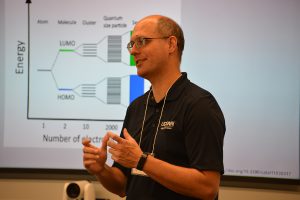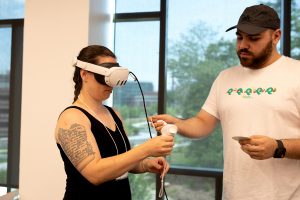If you have recently shopped for a new TV, did you wonder what the Q means in QLED? It stands for quantum, or the behavior of particles at the smallest scales, and it’s just one of the many ways a new era of quantum-based technology is revolutionizing everyday life.
However, most of the knowledge surrounding quantum science is understood and studied in college-level classrooms or by researchers. So, there is an immediate need to bring quantum instruction to high school chemistry classrooms, not only to cultivate the next generation of innovators in this area but also to educate all citizens about the current and future impacts of quantum on their lives.
Earlier this summer, faculty from UConn’s departments of Chemistry, Curriculum and Instruction, and Digital Media and Design hosted three days of professional development for high school chemistry educators, with the goal of creating new K-12 curriculum that teaches quantum chemistry concepts. The hope is for the new curriculum to eventually be used across the state and possibly nationwide.

“Professors possess enthusiasm about and knowledge of quantum concepts, while high school chemistry teachers possess knowledge of student-centered pedagogical strategies needed to support K-12 learners,” wrote Clyde Cady and Fatma Selampinar of the Department of Chemistry and Todd Campbell of the Department of Curriculum and Instruction in their grant proposal to support the project.
The three-day workshop was only the first step in their work, which is part of the larger QuantumCT partnership between UConn and Yale striving to make Connecticut “a leading hub for quantum technologies.” In late June, educators from around the state arrived in Storrs, where they spent their first day learning an overview of quantum science and its importance. They also toured different campus labs to view quantum dots using a microscope, and learning more about lasers and photochemistry; transmission electron microscopy (TEM); and scanning electron microscopy.
Day Two was dedicated to exploring and improving K-12 curriculum based on these topics. This was a highly collaborative effort, drawing on the UConn faculty’s expertise but also that of the high school teachers.
“We propose to focus on the teaching of atomic structure in general chemistry,” Cady, Selampinar, and Campbell said. “This topic already includes teaching quantum topics such as quantum numbers, electron orbital shapes and hybridization, and molecular orbital theory. These topics are the entry point to quantum mechanics but are often difficult to teach.”
To help with this, Jihyun An-Chakrin, a Ph.D. student in Curriculum and Instruction, collaborated with Campbell, Cady, and Selampinar to develop phenomenon-based curriculum that could anchor teacher professional learning experiences and collaborative refinement.

The third and final day was dedicated to helping the high school teachers visualize quantum concepts using virtual reality technology, so they in turn can help students do so as well. Cady, Selampinar, and Campbell note that most educators find it extremely hard to teach quantum science because the field is based on objects so small that you can’t touch, feel, or in any way easily interact with them – so, traditional teaching methods rely on mathematical equations. That’s where the work of Tomoyasu Mani and Jing Zhao of the Department of Chemistry and Ting Zhou of the Department of Digital Media and Design comes in.
“Visualization generally helps students learn concepts most effectively,” the three wrote in their project proposal. “VR can enhance the students’ engagement and interests during the learning process by enabling students to interact with 3D objects and improve their comprehension of challenging topics. … VR will help us create an interactive and immersive environment that connects the key phenomena/technologies and quantum concepts without excessively focusing on equations.”
Their first VR game focuses on Quantum Dots and their synthesis. Danial Ezzati, an MFA student in digital media design, collaborated with Mani, Zhao, and Zhou to develop this VR game.
In addition to VR learning, the team – named QuanXR – is also working to develop hands-on experiments and kits that help students visualize quantum theory. One of the kits is a series of quantum dots used in the Day Two activity. They are building a user-friendly website featuring the mascot “Qutie,” along with illustrations, animations, and films, to connect quantum concepts to real life. These can be used in tandem with the VR modules or alone, allowing more educators to utilize them even if their school or district doesn’t have access to VR equipment.
With the professional development workshop complete, both research teams hope to finalize their respective educational materials – curriculum guides, student worksheets, and other instructional materials for Cady, Selampinar, and Campbell, and the VR modules, hands-on experiments, and a website to distribute them all for Mani, Zhao, and Zhou – and support teachers who attended the workshop to test them in classrooms across the state. Feedback from teachers and students will continue to be crucial in these phases of the projects.
The materials were developed in alignment with the Next Generation Science Standard (NGSS), which are K-12 content standards that emphasize engaging learners in explaining things that happen in the world or solving problems of societal consequence and have been adopted either completely or partially by most of the states in the U.S.
“By developing curricular resources… we will not only improve how quantum science is taught in Connecticut but also in more than 40 other states [that have adopted or developed standards that have been adapted from the NGSS],” Cady, Selampinar, and Campbell say.
To learn more about QuantumCT, visit quantumct.org.



